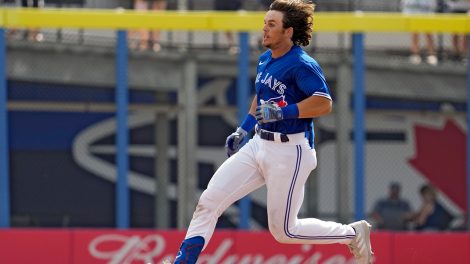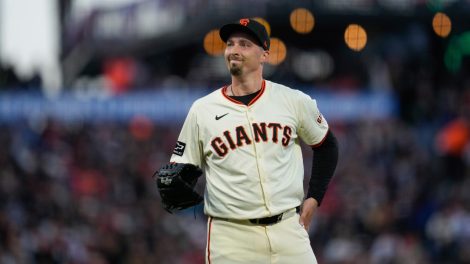• MLB reportedly proposes two changes to players’ union
• Rob Manfred focused on improving “pace of action”
• Blue Jays manager John Gibbons weighs in
TORONTO — They can’t say they weren’t warned. Whether or not Major League Baseball was ever really serious about instituting a pitch clock, the threat implicit in its use in the minor leagues should have warned people in uniform that, as far as Rob Manfred was concerned, they were “on the clock.”
And so it’s no surprise, then, that according to ESPN’s Jayson Stark the commissioner’s office has formally asked the MLB Players Association to agree to waive the four-pitch intentional walk in favour of an automatic walk while also indicating it wants to raise the bottom of the strike zone.
I mean, really, what else is there for Manfred to do? The game has labour peace, competitive balance and, bar stadium issues in Tampa and Oakland, is in boffo financial condition. The use of performance-enhancing substances is no longer a hot-button issue—you can say it’s under control if you want, but I’m still in a “fool me once” phase—and while they aren’t perfect, baseball at least has guidelines in place to deal with domestic violence. True, there is a sense that something’s amiss internationally but that’s hardly a core issue for Manfred.
No, pace of play—or, as Manfred wisely refers to it "pace of action"—is the way in which Bud Selig’s heir can make an indelible mark on the game. It is an issue: the average time of game dropped by six minutes in 2015 compared to 2014 after baseball decided to enforce existing rules preventing batters from stepping out of the box and put a clock on the amount of time between innings so that play began once commercial breaks were over. It was a start … but not enough for the commissioner, who saw the average major league game increase by four minutes last season.
Now, it is easy to quibble with these two new suggestions. First, it isn’t as if baseball has been plagued by an epidemic of intentional walks. Indeed, when Toronto Blue Jays manager John Gibbons was informed of that possible rule change on Monday, he had no reaction. Nada. Seriously, if it were possible for a shrug to travel via cellular telephone, that’s what would have happened. The only strategic issue is that it takes away from managers another ploy to get a reliever a few extra tosses in the bullpen.
But you can see what’s behind Manfred’s thinking, here. There is a strategic aspect to it: putting a pitch clock on the game is effectively Manfred’s nuclear option, and before he does that he is obligated to make some strategic strikes. Next in the hopper? How about limiting to two the number of warmup pitches from the mound once a reliever comes into the game? How about no more than one trip to the mound in an inning by the catcher or any other position player? How about continuing to enforce the existing rulebook, which really is a wonderfully constructed and nuanced thing?
Raising the strike zone is a little complex, but relies on a belief in how the game has changed. According to Stark, Manfred’s proposal—which would need to be OK’d pronto to come into effect for spring training—Fraises the lower part of the strike zone to the hitter’s knees from "the hollow beneath the kneecap," where it was moved in 1996. Stark cites studies showing the effect would be raising the strike zone by an estimated two inches. Theoretically, raising the strike zone should result in more harder hit balls in play which should lead to more offence which …
Wait. Weren’t there more homers per game per team hit in 2016 than in any season other than 2000? Haven’t we spent a lot of time this off-season talking about how there are too many mid-30ish, one-dimensional homer hitters on the market? And … how exactly does more offence guarantee a game will move quicker? Fewer walks and strikeouts, perhaps? More balls in play at a time when defensive shifts are in vogue and there is a new emphasis on athleticism and defence?
This is where "pace of game" meets "pace of action," and a lot of people aren’t sure what to make of it.
[relatedlinks]
"It helps the hitters and hurts the pitchers … so maybe it will come down to the the fact there are more players than pitchers who are members of the association," Gibbons said, chuckling. "I know there’s some sense out there that the game needs to speed up, but there’s so much that’s unique to this game … I worry that we might mess with it too much.
"The game changes. I understand that. And it all kind of works out. I mean, we changed the rule about sliding into home plate—and that kind of got ironed out. We changed the rule about sliding into second base and the neighbourhood play, and that kind of settled down as the season went on. It’s still going to come down to how each umpire calls the strike zone. You’re still going to have those differences. It might take a generation to change."
Gibbons does wonder what type of an effect the new zone would have on his young starters, such as Aaron Sanchez, who have been repeatedly drilled on throwing the sinker and missing down as opposed to up where real damage can be done. But Blue Jays pitching coach Pete Walker said Monday that they "have been working on elevating heaters more to take the pressure off being too fine at the bottom of the strike zone. We wouldn’t change anything we are doing (with our pitchers) unless it directly effects us."
Walker, for the record, would prefer the strike zone to stay where it is. I’m OK with that, too, and there seems to be a suggestion that the Players Association membership might not go along with it.
Look, I’m all with Manfred when it comes to carving out the amount of dead time during a baseball game—to a point. Tinkering with grey areas seems misguided when there is still some black and white editing available, such as the aforementioned mound visits.
I get chills when I hear Manfred talk about limiting the number of pitching moves per inning, because that is a fundamental interference with the strategic ebb and flow of the game. But I get what he’s doing. I get the endgame. It’s about time the uniformed personnel got it, too, and tried to reach a compromise with the man before time runs out.










